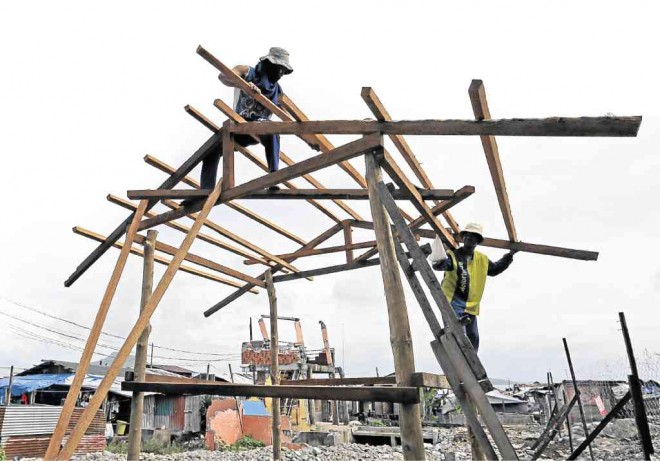Tacloban in 2015: Rising from the rubble

Residents of Barangay Anibong in Tacloban City continue to build houses after being destroyed by Supertyphoon “Yolanda” in 2013. RAFFY LERMA
Tacloban became a ghost city on Nov. 8, 2013, shortly after it was hit by Supertyphoon “Yolanda” (international name: Haiyan), the strongest typhoon to make landfall.
A total of 30,513 houses were destroyed and 23,718 others were damaged, according to city records. About 10,000 of those destroyed belonged to poor families.
More than 6,000 people were forced to live in tents, schools and evacuation centers, disrupting classes and other education-related services.
Severely damaged were seven hospitals, 17 barangay health centers and 25 elementary schools.
In its 2014 report on its “recovery and rehabilitation plan,” the city government said Tacloban’s location made it vulnerable to natural calamities.
Funnel effect
It lies on the path of typhoons, which hit the Philippines with an average of 20 every year. It is also situated in that part of Leyte Island where a funnel effect occurs, tending to invite the strongest storm surges.
The effect of climate change will intensify occurrences of Yolanda-like typhoons in Eastern Visayas. A situational report of the National Disaster Risk Reduction and Management Council dated April 3, 2014, showed that the number of Yolanda deaths in the region reached 6,293, of which 2,671 were from Tacloban.
According to the National Statistical Coordination Board, Tacloban’s population in 2010 was 221,174. The figure was believed to have been drastically reduced after the typhoon, but it was still expected to go up because of the influx of people from nearby towns and cities who would seek employment, put up businesses and study.
The city remains the center of trade and commerce and the educational hub in Eastern Visayas even if it was considered Yolanda’s ground zero.
Tourist arrivals
Immediately after the storm’s onslaught, the number of tourist arrivals in Tacloban dropped, according to the Philippine Statistics Authority. Hotels, motels, inns and pension houses reported that 222,301 checked in during the second quarter of 2013, but the figure went down to 132,902 in the last quarter.
A total of 797,655 tourists visited different destinations in the city during the second quarter, but only 486,394 came in the last quarter.
The steep decline was understandable, considering that many tourist destinations were damaged during the typhoon.
Banking services were disrupted after the storm surge and looting ensued later. Also affected were transportation and communication facilities, as well as water and power supplies.
Tourist arrivals, however, bounced when Pope Francis came on Jan. 17, 2015, and stayed for six hours. Thousands of pilgrims from nearby provinces converged in Tacloban to see him. Hundreds of volunteers from nongovernment organizations, foundations, institutions and private groups not only gave aid and relief assistance to survivors but also helped the hotel industry stay afloat.
Tzu Chi, a Taiwan-based foundation, was instrumental in helping Tacloban rise on its feet and accelerating its economic recovery. Significantly, a lone bank in Marasbaras served as Tzu Chi’s financing arm in assisting survivors through a cash-for-work program and unconditional aid to families ranging from P8,000 to P15,000.
The conduit bank estimated that recovery in investments already reached 83 percent as of December 2014. It observed that more loans were drawn by the business sector, especially in construction services.
This year, Tacloban expects a growth in investments as new businesses open and expand. Its recovery is laboriously coming into reality, as the city government wants to be considerate with the business community to attract investors.
Gross income as of third quarter of 2014 surpassed the target, city treasurer Zosima Cordaño said. Actual receipts reached P578,072,234.11, or more than P10 million over the goal.
Of the 12,900 business establishments recorded in December 2013, 60 percent or 7,825 applied for renewal of permits as of December 2014. Moreover, 1,191 new establishments applied for permits.
New businesses
The city government continues to extend the deadline for renewal of business permits without penalties.
Multinational companies, such as Foton, Mitsubishi, Ford and Toyota, have also reopened.
Malls, groceries and department stores, such as Robinsons, SaveMore, Gaisano Central and 578 Emporium are now open. So do popular fast-food chains, such as McDonald’s, Jollibee and Chowking.
In the meantime, the city gears up for the implementation of the Tacloban Recovery and Rehabilitation Plan.
Bernardita Valenzuela, executive assistant to Mayor Alfred Romualdez, said a new township would be built in the northern barangays.
Families in the coastal villages and other areas vulnerable to disasters will be relocated. Livelihood and health services, as well as transportation, education, water, power and communication facilities will be provided.
Redesigning the city
Included in the plan is the relocation of Eastern Visayas Regional Medical Center and the University of the Philippines Visayas Tacloban City extension campus to Barangay Cabalawan.
The seaside districts of Magallanes and San Jose will be turned into mariculture economic zones to enhance inland fishery production, to restore fish and other marine life, and to establish seaweed nurseries as part of a sustainable strategy to ensure food security.
Anibong District will be converted into a boulevard.
The city proper will be designed entirely for business and trade centers.
Valenzuela said it could take five to 10 years for Tacloban to fully recover after the devastation.
Barring any change in the political landscape and natural intervention, a highly urbanized Tacloban will be on track toward economic recovery.
The authors are members of the economics faculty of the College of Arts and Sciences of Eastern Visayas State University in Tacloban City.














